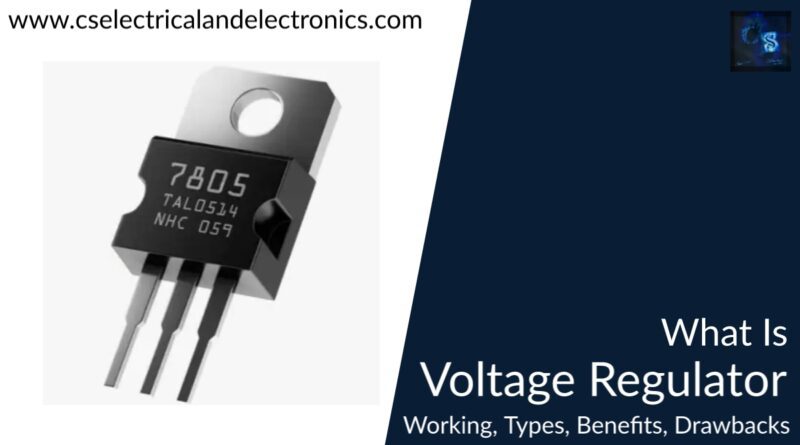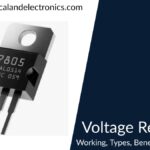What Is Voltage Regulator, Working, Types, Benefits, Drawbacks
Hello guys, welcome back to our blog. In this article, we will discuss what is voltage regulator, the working of a voltage regulator, types, series, shunt, switching VR, advantages, and disadvantages.
If you have any electrical, electronics, and computer science doubts, then ask questions. You can also catch me on Instagram – CS Electrical & Electronics.
Also, read:
- Power Electronics Applications In Different Fields, Power Electronics In EV.
- Skills Required For Power Electronics Engineer, Power Electronics Jobs.
- Top 10 MATLAB Projects For Electrical And Electronics Engineers.
What Is Voltage Regulator
A voltage regulator is that which is used for the regulation of the volt-age according to the requirement and the voltage regulator generates a fixed output volt-age irrespective of change in input or loads it is used for protection of components from damages, and it also acts as buffer the volt-age regulator is a simple feedforward designed and it uses for the negative feedback control loops.
The components used in the volt-age regulators are:-
- Feedback circuit
- Stable reference voltage
- Pass element control circuit
Working of the volt-age regulator
The input of the volt-age re-gulator gets from the power supply and it may vary but the output of the voltage regulator is maintained constant according to the requirement of all remaining equipment.
Types of volt-age regulators
- Linear voltage regulator
- Switching voltage regulator
Linear volt-age regulator
In the ohmic region the linear voltage regulator is acting as a voltage divider for this, it uses FET . for the constant output voltage the resistance of the volt-age re-gulator is varied according to the load, and for varying output voltage we utilize the MOSFET, BJT these active pass devices and which is controlled by a high gain operational amplifier and it adjusts the resistance bypass device by comparing internal voltage to the output voltage.
- Positive adjustable
- Negative adjustable
- Fixed output
- Tracking
- Floating
Advantages of a linear volt-age regulator
- Gives a low output ripple voltage
- Low electromagnetic interference and less noise
Disadvantages of the linear volt-age regulator
- Efficiency is very low
- Requires large space – heatsink is needed
- Voltage above the input cannot be increased
Series volt-age regulator
In this series voltage regulator the variable element connected to the load is series and the change resistance will change the voltage drops but the volt-age across the output is constant and the advantage of the series volt-age regulator is the current drawn is utilized by the load while there is no requirement of current at load at that time also the series regulator does not draw the full current so, the series voltage regulator has more advantage than the shunt volt-age regulator.
Shunt volt-age regulator
In this shunt voltage regulator, the load is connected in parallel so, the current flows through the ground uselessly as the shunt re-gulator current is diverted away from the load and it has a path from the supply volt-age to the ground through the resistance it is less efficient than the series regulator.
Applications Shunt Regulators
- Low Output Voltage Switching Power Supplies
- Current Source and Sink Circuits
- Error Amplifiers
- Voltage Monitoring
Switching volt-age regulator
The switching volt-age regulator has a series device it is rapidly switched on and off the amount of the charge transferred to the load is set as per the switch duty cycle, the switching volt-age regulator is also similar to the linear voltage regulator and it is controlled by a feedback mechanism In a switching regulator with Pulse Rate Modulation varying frequency, constant duty cycle and noise spectrum imposed by PRM is varied and this switching voltage regulator will not dissipate any power.
Advantages of Switching Volt-age Regulator
- The Switching Power Supply or Switching Volt-age Regulators is the efficiency. Usually, with better design efficiency, up to 95% can be achieved.
- As the transistor is oscillating between ON and OFF states, and the times it stays in the active region is very less, the amount of power wasted is very less.
Disadvantages of Switching Volt-age Re-gulators
- The complexity of the design of the switching power supply is very high.
- Due to frequent switching of the transistor and as a result of the transistor current, there exists a high interference and noise.
I hope this article may help you all a lot. Thank you for reading.
Also, read:
- 10 Tips To Maintain Battery For Long Life, Battery Maintainance
- 10 Tips To Save Electricity Bills, Save Money By Saving Electricity
- 100 (AI) Artificial Intelligence Applications In The Automotive Industry
- 100 + Electrical Engineering Projects For Students, Engineers
- 1000+ Control System Quiz, Top MCQ On Control System
- 1000+ Electrical Machines Quiz, Top MCQs On Electrical Machines
- 1000+ Electronics Projects For Engineers, Diploma, MTech Students
- 1000+ MATLAB Simulink Projects For MTech, Engineering Students
Author Profile
- Content Writer
Latest entries
 All PostsMay 3, 2021What Is Megger, Working Principle, Benefits, Types, Construction
All PostsMay 3, 2021What Is Megger, Working Principle, Benefits, Types, Construction All PostsMay 3, 2021What is Skin Effect, Cause Of Skin Effect, Drawbacks, Avoid It
All PostsMay 3, 2021What is Skin Effect, Cause Of Skin Effect, Drawbacks, Avoid It All PostsApril 29, 2021Types Of Power Electronic Converters, Applications Of Power Converters
All PostsApril 29, 2021Types Of Power Electronic Converters, Applications Of Power Converters All PostsApril 29, 2021What Is Voltage Regulator, Working, Types, Benefits, Drawbacks
All PostsApril 29, 2021What Is Voltage Regulator, Working, Types, Benefits, Drawbacks








